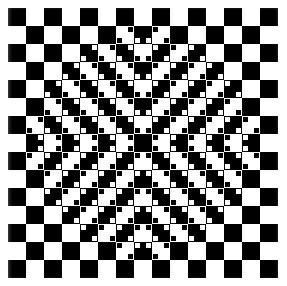« Best of JM: Numbers |
Main
| Driving sound. From the back. »
 August 29, 2013 | Best of JM: Sometimes things are less than they seem. August 29, 2013 | Best of JM: Sometimes things are less than they seem.
Enjoy the popular archive material below.
From December 10, 2009 | Numbers

The above was created by Akitaoka Akiyoshi; would you believe the lines in this picture below are completely parallel? The floor appears to bulge out, though this image consists of only squares. Look again.
For more pictures see Akiyoshi's illusion pages
In our recent December/January MandolinSessions, "Something Old. Something New." we take a look at a sequence of notes that is arguably the second most important scale/mode in jazz, eclipsed only by the Major Scale. Its incarnation in the article is called the "Augmented 11th Scale," but as you read farther, it's known by other names.
The pattern is incredible fodder for improvisation, and we hope to explain its potential in future articles here and at the Mel Bay MandolinSessions website. We actually introduced this in a very early submission (August 2004), describing its construction, and we cover some of its uses in the "Getting Into Jazz Mandolin" book. What we describe here is how similar it is to modes you already know and are probably using. Our goal is to develop drills that will make the sound of the scale a sonic entity unto itself.
What's intriguing about music theory is occasionally, you find commonalities that make the vast span of music creation shorter, rather than increasing the breadth of its complexity. In this case, we have three different scales that can be found in this one eight-note sequence, the Augmented 11th, the Altered Scale, and the ascending Melodic Minor Scale. The only difference in the patterns is the harmonic context.

What happens is when you learn this one sequence of notes, all you have to do is vary the starting note; you have the series in your fingertips. Hopefully they will be residing in your ear and brain as well.
Check out the article: Something Old. Something New.
Further:
Extending your vocabulary: The Augmented 11th
The Altered Scale: Bebop Mandology
Fingers, Ears, Brain
How do you think?
Posted by Ted at August 29, 2013 9:43 AM

Disclaimer: In the 'Information Age' of the 21st Century,
any fool with a computer, a modem, and an idea can
become a self-professed 'expert." This site does not
come equipped with 'discernment.'
|



